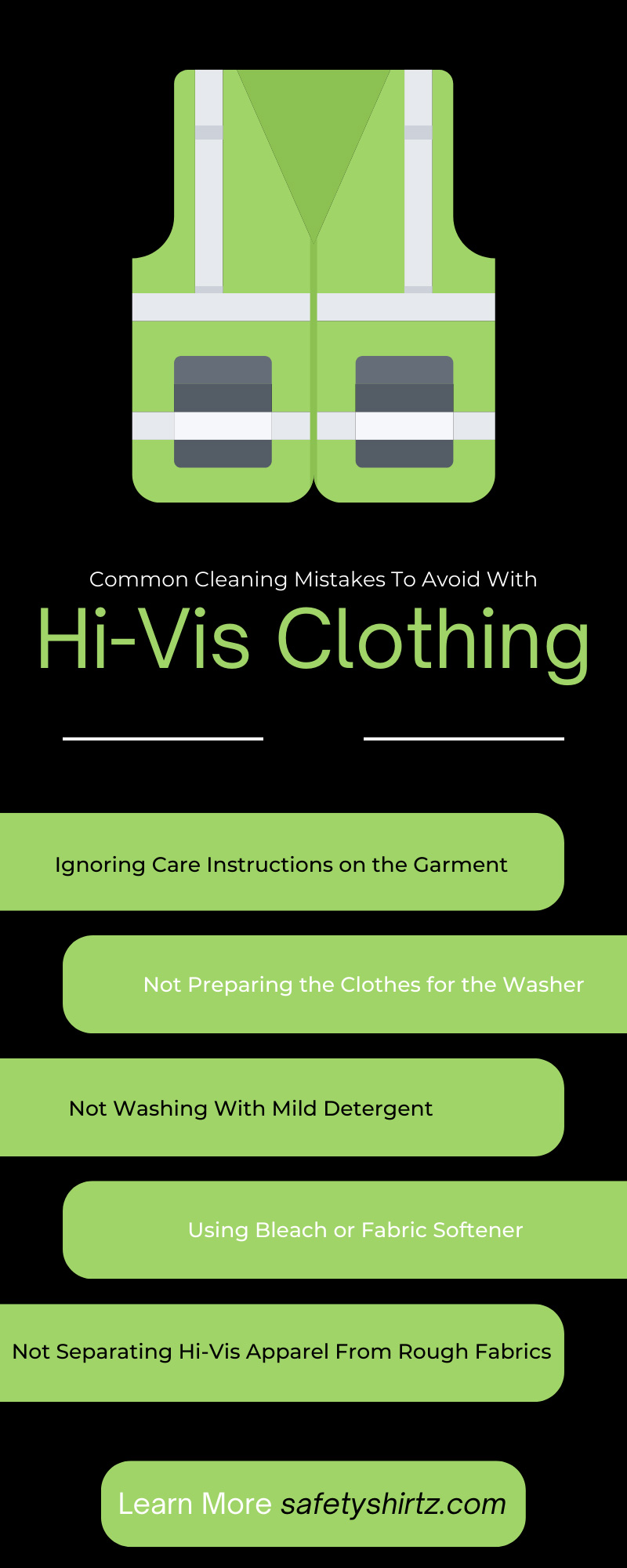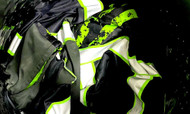Common Cleaning Mistakes To Avoid With Hi-Vis Clothing
4th Jan 2023
High-visibility workwear contains fluorescent fabrics and retroreflective materials. The bright colors of the garments increase your visibility in sunlight, and the retroreflective tape increases your visibility in low light.
To keep your garments ANSI-compliant and for your own safety, launder hi-vis clothes with care. Read on to learn common cleaning mistakes to avoid with hi-vis clothing.
Ignoring Care Instructions on the Garment
The wash instructions on your hi-vis apparel’s tag will list special instructions to protect the garment. You’ll find specifications regarding detergents, wash temperature, and whether you can machine dry the item.
The instructions will also specify if there’s a limit to the number of cycles you can wash the clothing. Once you reach that limit, dispose of the clothes. Multiple washes can cause the garments to fade, defeating the purpose of hi-vis clothes.
Not Preparing the Clothes for the Washer
Before you put your hi-vis clothes in the washer, you need to take a couple of minutes to prep the apparel by first removing debris and then pre-treating stains. Excess dirt can become abrasive in the washer. Shake off loose dirt and remove other debris with a clean, dry cloth.
Gently dab stubborn stains with a mild stain remover and a clean, dry cloth. Only use stain removers that don’t contain bleach.
Never scrub the fabric to remove a stain. Scrubbing can spread the stain and wear away the fabric, making the garment look worn out, which can reduce visibility.
Not Washing With Mild Detergent
No matter how dirty your hi-vis apparel gets, do not wash it with a harsh detergent. Always use a mild, neutral detergent and avoid using too much; otherwise, you risk leaving a residue that attracts dirt.
A mild detergent contains surfactants—a key cleaning ingredient—that dissolve grease and dirt. Like other bad laundry practices, washing with regular detergent can wear down fabric and damage the reflective tape on your clothes.
Using Bleach or Fabric Softener
For a normal load of white laundry, bleach can work wonders. However, it’s a harsh chemical that can wear down fabric fibers and discolor your hi-vis clothes. If you need a deeper clean than a normal wash, soak the fabric in water and detergent for 20 minutes in your washing machine before starting the wash cycle.
You might like to use fabric softener on your regular laundry loads to reduce static and make your laundry feel softer. You should never use fabric softener on hi-vis clothes—the product coats fabrics with a waxy layer that can damage your hi-vis gear.
Not Separating Hi-Vis Apparel From Rough Fabrics
Sorting laundry might seem like a hassle, but not separating hi-vis clothing from rough fabrics is a common cleaning mistake you should avoid. Rough fabrics like denim and hook-and-loop fasteners will rub continuously against your hi-vis clothes in the washer and dryer.
The rubbing will scratch the retroreflective material and fluorescent fabric, wearing away the garment and reducing visibility. Scratching the retroreflective fabric can reduce the coverage on your safety gear and leave you with less protection in low-light environments.
Washing in Hot Water
Machine wash hi-vis apparel in cold water and use your washer’s delicate cycle. Washing in hot water can warp the fibers, cause color bleeding, and damage the retroreflective material.
Many hi-vis garments are made with a polyester blend. The heat from a hot wash cycle can break down the fibers, causing them to thin or twist and ruining the appearance of the clothes.
If your hi-vis gear contains some spandex, hot water can ruin this fabric, too. The hot water will shrink the spandex fibers and distort the garment.
Line-Drying in Direct Sunlight
Some fabrics cannot be machine dried. And even if you can machine-dry fabrics, line-drying is more gentle. When you line-dry hi-vis clothes, don’t expose the clothing to direct sunlight.
Prolonged exposure to sunlight can fade the garments’ bright colors. The ultraviolet rays in sunlight can break down chemical bonds in the fluorescent pigments, dulling the colors. Line-dry in the shade and bring dry clothes into the house as soon as you can.
Not Using Low Heat in the Dryer
If the wash instructions on your hi-vis garment permit machine drying, always use low heat. High heat settings can damage the components that hold retroreflective tape in place. High heat can also weaken the fabric and retroreflective material, and cause the fluorescent colors to fade.
The low heat setting relies more on the air drying of tumbling the clothes than on heat drying. It will take a bit longer to dry your clothes on this setting, so don’t overload the dryer. The fewer items you have in the dryer, the more air can circulate all around the fabric and dry efficiently.
Wringing Clothes To Dry Them Faster
Whether you’re line-drying or drying the garment on low heat in your machine, you might feel tempted to speed up the process. You should never wring your clothes to dry them out faster.
Wringing creates a lot of tension throughout the fabric, applying unnecessary force to the garment. This movement can also damage the retroreflective tape.
Retroreflective tape works by reflecting light back to the source with minimal scattering. The retroreflective material consists of small glass beads or microprisms placed to create the highly concentrated reflected light, and abrasion will ruin the beads or microprisms.
Leaving Clean Clothes Rumpled
Leaving clean clothes in the dryer or in a pile to be sorted later can damage the fabric. For normal laundry loads, you usually don’t have to worry about this. But you want to protect the retroreflective material from unnecessary contact with other items to prevent scratches.
You also can’t iron hi-vis clothes. The intense, focused heat can damage the garments, so avoid wrinkles by taking your gear straight from the dryer to the closet.
These ten laundry mistakes can weaken fabric, decrease color vibrancy, and cause abrasive damage. Avoiding these issues will keep your hi-vis clothes in the best shape and keep you protected.
For great-looking high-visibility safety apparel, shop with SafetyShirtz. Our designs combine form and function to create stylish garments that maintain visibility standards. Find your new hi-vis shirt, jacket, or hoodie today.


